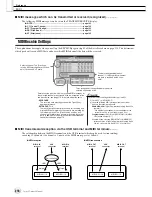
MIDI
Reference
212
Tyros2 Owner’s Manual
This section covers basic information on data compatibility: whether or not other MIDI devices can playback the data
recorded by Tyros2, and whether or not the Tyros2 can playback commercially available song data or song data created
for other instruments or on a computer. Depending on the MIDI device or data characteristics, you may be able to play
back the data without any problem, or you may have to perform some special operations before the data can be played
back. If you run into problems playing back data, please refer to the information below.
Sequence format
Song data is recorded and stored in a variety of different systems, referred to as “sequence formats.”
Playback is only possible when the sequence format of the Song data matches that of the MIDI device.
●
SMF (Standard MIDI File)
This is the most common sequence format. Standard MIDI Files are generally available as one of two types:
Format 0 or Format 1. Many MIDI devices are compatible with Format 0, and most commercially available
software is recorded as Format 0. The Tyros2 is compatible with both Format 0 and Format 1. Song data
recorded on the Tyros2 is automatically recorded as SMF Format 0.
●
ESEQ
This sequence format is compatible with many of Yamaha’s MIDI devices, including the Tyros2 series
instruments. This is a common format used with various Yamaha software. The Tyros2 is compatible with
ESEQ.
●
XF
The Yamaha XF format enhances the SMF (Standard MIDI File) standard with greater functionality and
open-ended expandability for the future. The Tyros2 is capable of displaying lyrics when an XF file contain-
ing lyric data is played.
●
STYLE FILE
The Style File Format—SFF—is Yamaha’s original style file format which uses a unique conversion system
to provide high-quality automatic accompaniment based on a wide range of chord types. The Tyros2 uses
the SFF internally, reads optional SFF style disks, and creates SFF styles using the Style Creator function.
Voice allocation format
With MIDI, voices are assigned to specific numbers, called “program numbers.” The numbering standard (order
of voice allocation) is referred to as the “voice allocation format.” Voices may not play back as expected unless
the voice allocation format of the song data matches that of the compatible MIDI device used for playback.
●
GM System Level 1
“GM System Level 1” is a standard specification that defines the arrangement of voices in a tone generator
and its MIDI functionality, ensuring that data can be played back with substantially the same sounds on any
GM-compatible tone generator, regardless of its manufacturer or model.
●
GM System Level 2
“GM System Level 2” is a standard specification that enhances the original “GM System Level 1” and
improves song data compatibility. It provides for increased polyphony, greater voice selection, expanded
voice parameters, and integrated effect processing.
●
XG
“XG” is a tone generator format that expands the voice arrangement of the “GM System Level 1” specifi-
cation to meet the ever-increasing demands of today’s computer peripheral environment, providing richer
expressive power while maintaining upward compatibility of data. “XG” greatly expands “GM System
Level 1” by defining the ways in which voices are expanded or edited and the structure and type of effects.
When commercially available song data bearing the XG logo is played back on a tone generator which bears
the XG logo, you will enjoy a full musical experience that includes unlimited expansion voices and effect
functions.
●
GS
GS was developed by the Roland Corporation. In the same way as Yamaha XG, GS is a major enhancement
of the GM specifically to provide more Voices and Drum kits and their variations, as well as greater expres-
sive control over Voices and effects.
MIDI Data Compatibility
Summary of Contents for 2
Page 1: ...Owner s Manual EN ...
Page 236: ...Tyros2 Owner s Manual ...


































